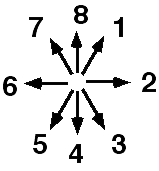A2L Item 031
- Description: Identify the direction of the force caused by an accelerated object on the traversed surface.
- Goal: Hone the vector nature of force and interrelate model and procedure forces.
- Source: UMPERG
- Keywords: Dynamics, Forces, Friction, Mechanics, Newton's Third Law
The question for students:
A marble rolls on to a piece of felt and slows down.

Indicate the direction that most nearly corresponds to the direction of the force that the marble exerts on the felt. If none of the directions are appropriate, or if the answer cannot be determined, respond (9).

Commentary for teachers:
Answer
(3) The force the felt exerts on the marble is up (normal force) and to the left (friction force). Newton’s third law tells us that the force the marble exerts on the felt must be down and to the right. Students may focus on the normal force alone (4) or the friction force alone (2). These are not two forces, but the components of a single force. Students also find it difficult to extract some information from the dynamical statement “slows down” and integrate this with the familiar normal force.
Background
This presents an interesting twist to students. The friction force is usually formulated in terms of a moving object and a fixed surface. Students may not know for sure whether there is a friction force on the felt - the felt is not moving. The analysis on the marble is reasonably straightforward. Newton’s third law can be used to determine the force on the felt if the force cannot be determined from the situation directly.
Questions to Reveal Student Reasoning
Question students about how they got their answer. Did they use the force laws that they learned previously? Did they use Newton’s second or third laws?
Suggestions
Instead of a marble consider a sliding block and see if students think differently - some students will have difficulty thinking about friction with a rolling object.